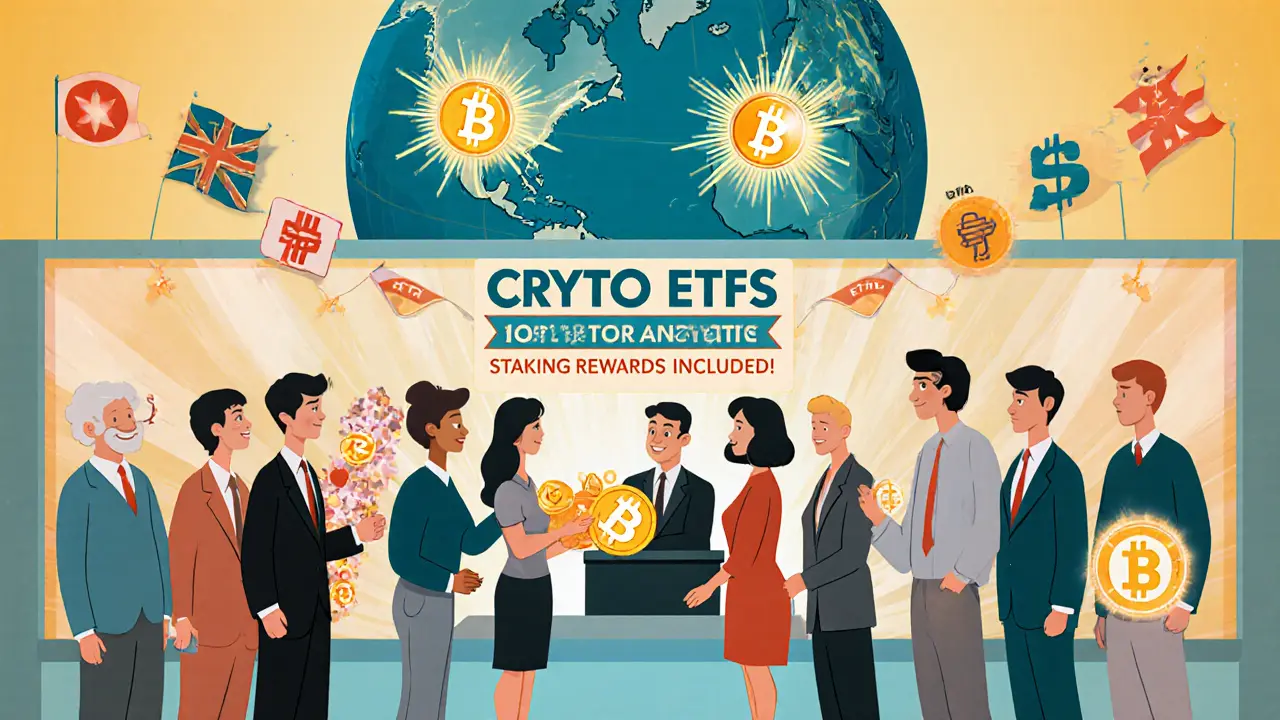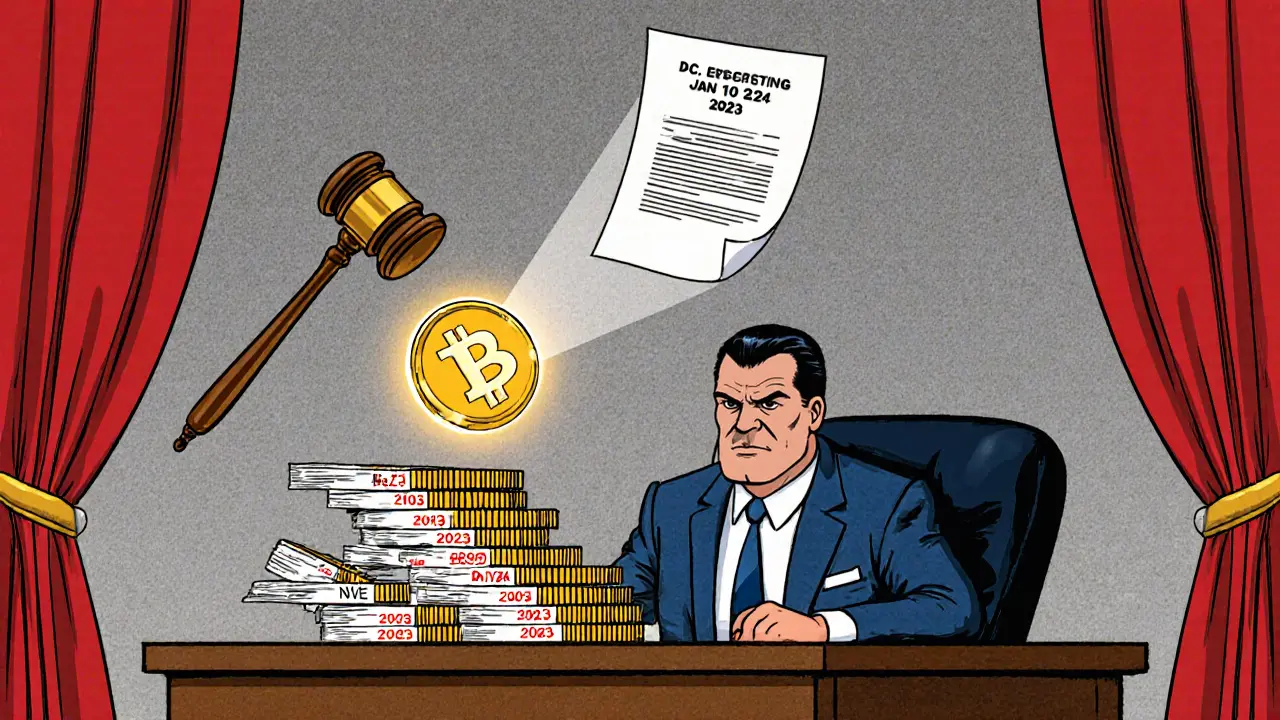ETF Fee Comparison Calculator
Compare ETF Costs
Select your investment type, amount, and ETF to see annual costs and staking rewards
Results
Annual Fee: $0.00
Staking Rewards: $0.00
Total Annual Cost: $0.00
Key Considerations
Important
Staking rewards are taxable as ordinary income. Fees are annual management charges only.
For Ethereum ETFs with staking: Grayscale ETHE provides 4.2% staking rewards (approx. $127M quarterly). VanEck EETH does not participate in staking.
Before January 2024, buying Bitcoin or Ethereum through a traditional brokerage was impossible in the U.S. You had to use exchanges like Coinbase or Binance, hold your own keys, and deal with complex tax reporting. That all changed when the SEC approved the first spot Bitcoin ETFs. Then, six months later, Ethereum ETFs followed. These weren’t just new products-they were a complete reset of how Wall Street sees digital assets.
Why the SEC Waited Over a Decade
The SEC rejected 13 Bitcoin ETF applications between 2013 and 2023. Each time, they said the same thing: crypto markets are too risky, too unregulated, too easy to manipulate. But in August 2023, a federal court forced their hand. The D.C. Circuit ruled that the SEC had been inconsistent-approving Bitcoin futures ETFs while blocking spot ones, even though both tracked the same underlying asset. That decision was the turning point. The SEC couldn’t keep arguing against spot Bitcoin ETFs without looking arbitrary. By January 10, 2024, they approved eight Bitcoin ETFs, including BlackRock’s IBIT and Fidelity’s FBTC.How the First Bitcoin ETFs Worked (and Why They Were Clunky)
The first Bitcoin ETFs didn’t let you trade actual Bitcoin. Instead, they used a cash-only model. If you wanted to buy shares in IBIT, you paid cash. If you wanted to redeem them, you got cash back. The ETF provider had to buy and sell Bitcoin on the open market to match the flow. That created problems. Every time shares were created or redeemed, the ETF had to execute a trade, which meant paying fees and triggering capital gains taxes for all shareholders. It was inefficient. And it kept big holders-like crypto whales who owned millions of Bitcoin-from moving their assets into ETFs without selling.Ethereum ETFs Came With a Twist
When Ethereum ETFs launched on July 23, 2024, they weren’t just copies of Bitcoin ETFs. Ethereum runs on proof-of-stake, which means holders earn rewards by locking up their ETH to help secure the network. That’s called staking. The SEC allowed ETF providers to participate in staking, but only if they disclosed it clearly. Grayscale’s ETHE chose to stake 4.2% of its ETH holdings. That generated $127 million in rewards in just one quarter. Those rewards were distributed to shareholders as dividends. Other ETFs, like VanEck’s EETH, opted out of staking entirely. The result? Ethereum ETFs became more than price trackers-they became yield-generating instruments. That made them more attractive to income-focused investors.The Big Shift: In-Kind Processing Arrives
On July 29, 2025, the SEC made its most important move yet: it approved in-kind creation and redemption for crypto ETFs. Now, instead of exchanging cash, authorized participants can deliver actual Bitcoin or Ethereum to create ETF shares-and get the same crypto back when redeeming. This is how gold ETFs like GLD have worked for 20 years. It’s simpler, cheaper, and tax-efficient. No more buying and selling crypto on the open market. No more capital gains taxes triggered by ETF flows. BlackRock processed over $3 billion in Bitcoin conversions using this new system by October 2025. Bitwise and Galaxy Digital saw their client demand for in-kind conversions jump by 47% and 63% respectively in the same quarter. This change turned ETFs from speculative tools into practical custody solutions for institutions.
Fee Wars and Market Share
Fees became a battleground. Bitcoin ETFs average 0.25% in annual management fees. Fidelity’s FBTC charges 0.00%-zero. BlackRock’s IBIT charges 0.25%. Grayscale’s GBTC? Still 0.90%, even after converting from a trust. Ethereum ETFs are more expensive. They average 0.35%. VanEck’s EETH is the cheapest at 0.15%. Grayscale’s ETHE? 1.50%. That’s not a mistake-it’s a premium for brand recognition and the fact that ETHE was the only Ethereum product available before ETFs. Investors are voting with their wallets. IBIT now holds $16.9 billion in assets, or 31.2% of the total Bitcoin ETF market. ETHE leads Ethereum ETFs with $5.1 billion, but its high fee is slowing growth. New entrants like Fidelity’s FETH are gaining fast.Market Behavior: Bitcoin Outflows, Ethereum Inflows
Despite the hype, the market isn’t moving in lockstep. In Q3 2025, Bitcoin ETFs saw $1.2 billion in net outflows. Why? Rising interest rates made bonds and Treasuries more attractive. Investors pulled money out of riskier assets. Ethereum ETFs, meanwhile, saw $478 million in net inflows. That’s not a fluke. Ethereum’s staking rewards made it a better yield play. Plus, institutional investors are using Ethereum ETFs to access DeFi-like returns without the complexity of managing smart contracts. Reddit users praised the regulatory clarity but slammed Grayscale’s fees. Trustpilot reviews for Coinbase’s ETF integration show 72% of users liked the ease of moving from self-custody to ETF exposure-but 28% complained about confusing tax forms for in-kind trades.What’s Next? Solana, XRP, and the Global Wave
The SEC’s October 2025 orders didn’t just open the door for Bitcoin and Ethereum. They said it applies to “a host of crypto asset ETPs.” That means Solana, Cardano, and even XRP could be next. The Hong Kong Stock Exchange launched its first spot Solana ETF on October 23, 2025, charging 0.99%-higher than most U.S. ETFs, but still a milestone. Evernorth, a major asset manager, quietly bought $1 billion worth of XRP in October 2025 for yield strategies. That’s a signal. If XRP can generate returns through DeFi protocols, an XRP ETF isn’t far behind. Meanwhile, the UK’s FCA lifted its ban on crypto ETNs, letting UK retail investors buy Bitcoin and Ether ETFs inside tax-free ISAs. This isn’t just a U.S. story anymore-it’s global.
Why This Matters for You
If you’re holding Bitcoin or Ethereum in a wallet, you now have a better way to store it: through an ETF. No more worrying about private keys. No more exchange hacks. No more tax chaos from trading. With in-kind processing, you can move crypto into an ETF without selling it. That’s huge for estate planning, institutional portfolios, and even retirement accounts. The SEC’s shift isn’t about making crypto mainstream-it’s about making it *manageable*. The market is no longer just speculators. It’s pension funds, endowments, and family offices. And they’re not here to gamble. They’re here to allocate.What Still Doesn’t Work
Not everything is fixed. The SEC still hasn’t clarified whether staking rewards are taxable income or capital gains. The IRS hasn’t issued guidance. Tax software still doesn’t handle staking distributions from ETFs cleanly. Some providers, like Grayscale, are still charging 1.5% fees on Ethereum. That’s a rip-off compared to VanEck’s 0.15%. And while in-kind processing reduces costs, it doesn’t eliminate them. You still pay management fees. You still get taxed on distributions. And if you’re a retail investor, you’re still at the mercy of ETF liquidity. If a big player dumps their shares, the price can swing.Where the Market Is Headed
By December 2026, experts predict Bitcoin and Ethereum ETFs will hold over $150 billion combined. In-kind processing will save the industry $500 million a year in operational costs. More ETFs will launch. More countries will follow. But the SEC isn’t done. Chairman Paul S. Atkins said clearly: “Not all crypto assets will qualify.” That means Dogecoin, Shiba Inu, and meme coins won’t get the green light. Only assets with clear utility, transparent networks, and institutional-grade custody will make the cut. Bitcoin and Ethereum are the first two. They’re not the last-but they’re the ones that changed everything.Are Bitcoin and Ethereum ETFs safe?
They’re safer than holding crypto on an exchange because they’re regulated by the SEC and held by approved custodians like Coinbase Custody or Fidelity Digital Assets. But they’re not risk-free. The price still swings with Bitcoin and Ethereum’s market value. And if the ETF provider mismanages staking rewards or fails to hedge properly, you could lose money. They’re a better way to invest-but not a guarantee.
Can I buy Ethereum ETFs on Robinhood or Fidelity?
Yes. Fidelity offers FETH. Robinhood now lists several Bitcoin and Ethereum ETFs, including IBIT and ETHE. Most major brokers-including Schwab, TD Ameritrade, and Vanguard-now support crypto ETFs. You don’t need a crypto wallet. Just log in like you’re buying Apple stock.
Do Ethereum ETFs pay dividends?
Some do. Grayscale’s ETHE pays quarterly staking rewards to shareholders. Others, like VanEck’s EETH, don’t. It depends on the provider’s choice. Always check the ETF’s prospectus. If you want yield, look for ETFs that explicitly state they participate in staking. Don’t assume it’s automatic.
Why are Bitcoin ETF fees lower than Ethereum ETF fees?
Bitcoin ETFs are more competitive because they launched first and have more providers. Fidelity undercut everyone with a 0.00% fee. Ethereum ETFs are newer, with fewer players, and Grayscale still charges a premium because it was the only option before. As more providers enter, Ethereum fees will drop. VanEck’s 0.15% fee proves it’s possible.
Should I sell my Bitcoin and buy a Bitcoin ETF instead?
Not necessarily. If you’re comfortable managing your own keys and understand the risks, holding Bitcoin directly still gives you full control. But if you want simplicity, tax efficiency, and institutional-grade custody, an ETF is a better option. With in-kind processing, you can now move Bitcoin into an ETF without selling it-so you don’t trigger capital gains. That makes the transition much easier.
Will other cryptocurrencies get ETFs soon?
Yes. Solana already got one in Hong Kong. XRP and Cardano are likely next. The SEC’s October 2025 ruling opened the door for “a host of crypto asset ETPs.” But they’ll only approve assets with strong networks, clear governance, and reliable custody. Meme coins and low-liquidity tokens won’t make the cut.
Are crypto ETFs taxed differently than holding crypto directly?
For capital gains, no-you’re still taxed when you sell shares. But staking rewards from Ethereum ETFs are treated as ordinary income, not capital gains. That’s a big difference. If your ETF pays $1,000 in staking rewards, you pay income tax on that amount, even if you didn’t sell anything. Keep good records.
